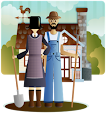This year we'll replace the wood framing on the last four of our beds (hooray!) that we've also used for the last 20 years.
The above two pictures show some of
the rotting that has occurred
in the wood framing.
It's a project we've been working on for about the past 3-4 years, replacing a few each year. When these last four are done, all the wood framing of all our raised beds will be "new" and hopefully good for another twenty years of raising delicious, nutritious food.
Our first frames were made of two 2" x 6" boards stacked one on top of the other to equal a height of 12". We used the 6" boards because we had them, but it wasn't the wisest move. They didn't hold up nearly as well as the 2" x 12" boards we've used since then.
Initially we nailed them together into a 4' x 8' rectangle, but found with the soil freezing and thawing over the years, the joints started to pull apart, and we had to reinforce the corners with metal "L" brackets.
Using screws as fasteners works much, much better.
The screws which seem to do the best job are these.
The type of wood we've experimented with has included local rough-cut white cedar, tamarack and pine. The longevity of each has been about the same.
For the ones we've been replacing recently, we've used pine or fir from the local lumber yard with two applications of tung oil, thinking this would prevent rotting longer than unfinished boards. Time will tell if this proves out to be true.
When questioned, my husband stated that if we have to replace raised bed framing again after this time around, he'd like to go with a good quality western red cedar . . . probably with the coating of tung oil as a preservative again.
Although there's no question that pressure treated lumber for the raised bed framing would last longer, and supposedly the chemicals used in the pressure treating process are not as toxic as they once were, we wouldn't feel comfortable using any pressure treated product that comes in direct contact with the soil in which we grow our food.
Hope this gives an overview of the construction of our raised beds, and answers your questions, Karen.









.jpeg)












13 comments:
Mama Pea,
Really nice post about putting the raised beds together with wood, and screws.
Screw I believe are the secret to holding better. As for using tung oil, I've not used it. Let us know if this makes a difference in the wood.
Hugs,
Sandy
Very informative! And, I can actually see your dirt. Oh wait, there's that little strip of snow. Do you think the snow is over, now? I'm ready for you to get to planting. HaHa! I want to see!
You are doing a good job! Have a nice day!
We just started putting cedar beds in last year. We did 4 beds--as the bank people didn't think our house was worth more than that. Ha.
:D
I cannot get over how much cedar is now. It's a huge investment. Not sure it will "pay-off", but we thought we'd try a few beds of it.
I haven't gone to raised beds yet.....but am considering trying one. Great tips. Thank you.
Sandy - It will probably be several years before we can ascertain if the tung oil has made a difference, but since it's a natural, non-toxic material we figured it was worth a try. :o}
Laurie - I sure hope any amount of snow (just scattered flakes?) that falls now won't amount to anything, but you never know! So far this year, I'm behind being able to get into the garden (still partially frozen and otherwise MUD) but temps up into the 50s are forecast for the rest of this week. Yay!
WW - Thank you!
Sue - I know just what you mean! Seems like everything we go to purchase, we joke(?) about having to stop at the Credit Union to take out a loan first! Arrrrgh.
gld - You're very welcome. I LOVE the raised beds for some things, but others like corn, beans, potatoes, peas, etc., I'll always want to plant in my field garden, the old traditional way. In my raised beds I'm able to plant intensively, get great harvest and next to no weeds!
I will be having to replace mine at some point. I'm hoping that point will be after I have moved...
Susan - Before finding this place, and after leaving our first place in MN, we rented for a time and had the landlords permission to put in five raised beds in the back yard for a few vegetables. When we moved to this little homestead, we took the frames of the raised beds with us! Not sure that is the most efficient way to do it though . . . :o]
Great post! Good information for when we add more raised beds.
Post a Comment